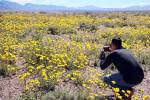Desert-friendly landscapes benefit valley
It has been hard watching once-lush lawns, shrubs and trees die in abandoned landscapes. It’s also heartening to see water-conserving plants suited for our climate continue to survive even though homeowners turned off the water.
Seeing this disparity highlights the need to install more desert-friendly, water-efficient landscapes in our valley.
This not only reduces the strain on our already scarce and most precious natural resource — water — but it also helps reduce our water bills.
Mountain States Wholesale Nursery in Phoenix thrives on finding water-conserving plants, coming to us with bushels of color to brighten up even the most dreary landscapes with little or no maintenance. Jean Cote from Mountain States Nursery provided me with a list of some newer varieties showing great promise to color your yard:
Brakelights red yucca: This red yucca stops traffic with its vibrant red flowers, which rise 3 feet above a knee-high compact plant so you don’t have to lean over to smell the flowers, and hummingbirds love them. It’s a slow “forget me plant” with narrow, leathery, blue-green leaves. It thrives in full sun and heat bouncing off hot walls, including containers. It comes from Texas and northern Mexico and thrives in our soils. When compared with traditional red yuccas, you’ll pick brakelights every time.
Variegated Murphey’s agave: The late Rodney Engard, a noted Arizona plant man, selected this beautiful agave. It gets about knee high and 3 feet wide. As its name implies, the variegated leaves have yellow stripes outlining blue-green centers. Occasionally it produces offsets, but after several years in your landscape, when the mother plant sends up its flowers, it dies. Like most agaves, it tolerates our heat and full sun with minimal water.
“Bubba” desert willow: This particular desert willow is a vigorous and brawny tree which gets about 30 feet tall. Expect to have a profusion of large, dark burgundy, fragrant flowers through the summer. This tree covers itself with slender, glossy, dark green leaves to help accent the flowers. It’s a great choice for low maintenance, water-wise sunny landscapes. It does produce some seedpods.
Art’s seedless desert willow: The late Art Combe found this desert willow at his nursery in Littlefield, Ariz. He had the reputation of being able to find a needle in a haystack. And this he did, when he found Art’s seedless desert willow. It’s very popular in our desert landscapes because of its large, showy flowers through the summer and its attraction of hummingbirds. Unfortunately, most desert willows produce seedpods, which persist and become unsightly on plants. Combe called all desert willows “poor man’s orchids.”
Rock penstemon: This shrubby perennial forms small clumps of dark green, succulent foliage. In the spring to early summer, spikes rise above the foliage covered with vibrant rose-red flowers, becoming very eye-catching. It’s one of the most colorful penstemons. Plant them in well-drained soils so they perform at their best where they will get some afternoon shade. It tolerates our winters.
Pam’s pink honeysuckle: This vine covers itself with two-lipped, lengthened flowers in pastel hues of cream and pink. The lightly scented blossoms attract nectar-seeking insects and birds from midspring into fall. This tough vining shrub has the desirable traits of common honeysuckle, tolerates our soils and becomes drought tolerant once established.
The blue-green foliage has a waxy surface, an obvious reason it’s tough in our conditions. It’s bushy in appearance, growing waist high and 6 feet wide. Use it as a filler plant, in containers or in informal gardens. Cut this beauty back periodically to maintain its size.
Sierra apricot Tecoma: This petite new Tecoma delivers a powerful punch of apricot color that blooms continuously throughout the summer, with large clusters of bell-shaped flowers so the hummingbirds love it. If it freezes down, cut the stems back and it will flush out quickly next spring.
Germander: This tough, low growing evergreen comes to us from the Mediterranean. Spikes of pink-purple flowers adorn the plants in the spring and cooler parts of the year.
It tolerates the sun and reflected heat and colder temperatures. In the late winter prune it back and remove spent blossoms to keep it looking sharp.
Linn Mills’ garden column appears on Sundays. You can reached him at linnmillslv@gmail.com or call him at 526-1495.























